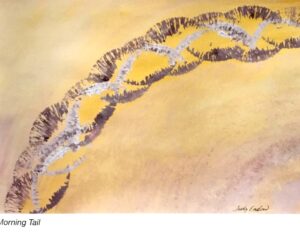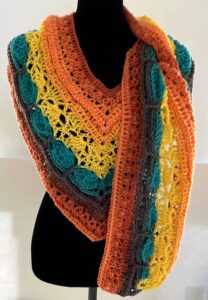This is the second part of a five-part blog series with this outline
Part One: Personal Background Information (Release Date: 3-16-22)
Part Two: Information Storage – Bridge Pieces (Release Date: 3-30-22)
Part Three: Information Processing – The Gaps (Release Date: 4-13-22)
Part Four: Information Retrieval – Canoe Transportation (Release Date: 4-27-22)
Part Five: Conclusion (Release Date: 5-11-22)
Bridge Pieces: Information Storage
The stone island stones
in that inside-my-mind space
have little bridge pieces jutting off them
in varying places
from their surface of stone.
Pieces of bridges, but never a whole bridge,
connecting any two surfaces of different islands
each one containing its very own specific information
set in stone
for one and only one
specific eventuality
learned from life previously
recorded historically
immovable, unchangeable
set as set can be
in stone island cemented reality
encapsulated, preserved for all time
forever, eternally
with no bridges connecting –
no way of sharing
one island’s info
with any other.
That’s why there are gaps
in that gray-matter space of her mind’s place
where she knows bridges should be
but are not there to connect
this info with that
and therefore no way
to extrapolate
info from one specific,
circumstantial island of stone
and apply it to something
a little bit slightly different
that might be occurring
just now in her life.
Sometimes she becomes quite frustrated
when she finds herself in a new situation
and isn’t able to gather together, sift and apply
bits of info from several stone islands
already in existence,
bobbing around, each one minding its own business –
never connecting
each their own info
one with another
because they can’t
having only bridge pieces – no whole bridges
anywhere to be found between islands
to span all the gaps.
If only world-people could see into that gray-matter space of her mind
a suspension of matter that matters
because it supports her many islands of stone
each one with their purpose of holding
pertinent, specific world-information
of what-to-do-when
and
how-to-act-if
and
when-to-say-what
solid information
cast in stone
solidified in place
in that gray-matter space
of her
mind.
Then world-people might see the little bridge pieces
stuck onto the sides of all these stone islands.
Bridge pieces just hanging there serving no purpose
(other than to underline the fact
that a bridge was meant to be there, but isn’t)
little bridge pieces going nowhere
with gray-matter gaps
where thee bridges
should be.
Perhaps then the world-people might come to understand
that even though she may know
all the info that’s needed to answer their question
or to produce a reciprocal response
to keep up with her part of their conversation,
sometimes it takes a lot of her time
to jump in a boat and float around
in that gray-matter space of her mind
floating in the gaps trying to find
all the right islands of stone
that might hold any relevant data
pertinent to the subject
at hand.
Sometimes it’s a cumbersome task
to access information in this manner
and other times
it is downright impossible.
It’s at these times when she knows that she knows all of the relevant data
and desperately tries to locate it and can’t
she knows that she knows it, but can’t tell you right now
at this very minute
exactly what it is
(and she may not even know it an hour from now)
because what she needs
can’t be fit together
to make any logical sense.
Please try to remember
she’s dealing with gaps
because there simply are
no bridges.
And at these particular times she tends to look very directly
at the person who is talking to her
(as if she might find what she’s looking for
by staring intensely right into that person’s eyes).
Sometimes she gets a goofy little half-grin
(or so she’s been told,
but as for herself never notices this).
During this time she’s marking time
waiting for the info she needs to come in
hoping to be able to fill in the gaps
with the info she knows that she knows,
but try as hard as she might,
she right now can’t find.
Invariably an exasperated, superior world-person will declare with finality,
“YOU KNOW EXACTLY WHAT YOU ARE DOING!”
and disgustedly walk away.
But if he doesn’t leave too fast he might hear her agree
because after all she already knows that she knows,
but just doesn’t know what it is
(or if she is told the info she is lacking
she can and may even repeat it back,
but to her, even the right info
supplied as it may be by frustrated world-people
has no present meaning to her
and therefore cannot be applied right now
to this particular situation in today’s reality).
She tries very hard to be acceptable.
She may even be able to say the right words,
repeating what someone
outside her supplied.
But her understanding
is blank just then.
She really can’t help it,
She has gaps, not bridges.
Selection from Autistically Thriving: Reading Comprehension, Conversational Engagement, and Living a Self-Determined Life Based on Autistic Neurology, pgs. 105-108.
The first photo is an afghan I crocheted to match the acrylic painting shown in the second photo.
`
`
Note: The author is a mental health therapist and is also autistic. She intentionally uses identity-first language (rather than person-first language), and invites the reader, if interested, to do further research on the preference of most autistic adults to refer to themselves using identity-first language.
BOOKS BY JUDY ENDOW
Endow, J. (2021). Executive Function Assessment. McFarland, WI: Judy Endow.
Endow, J. (2019). Autistically Thriving: Reading Comprehension, Conversational Engagement, and Living a Self-Determined Life Based on Autistic Neurology. Lancaster, PA: Judy Endow.
Endow, J. (2012). Learning the Hidden Curriculum: The Odyssey of One Autistic Adult. Shawnee Mission, KS: AAPC Publishing.
Endow, J. (2006). Making Lemonade: Hints for Autism’s Helpers. Cambridge, WI: CBR Press.
Endow, J. (2013). Painted Words: Aspects of Autism Translated. Cambridge, WI: CBR Press.
Endow, J. (2009b). Paper Words: Discovering and Living With My Autism. Shawnee Mission, KS: AAPC Publishing.
Endow, J. (2009a). Outsmarting Explosive Behavior: A Visual System of Support and Intervention for Individuals With Autism Spectrum Disorders. Shawnee Mission, KS: AAPC Publishing.
Endow, J. (2010). Practical Solutions for Stabilizing Students With Classic Autism to Be Ready to Learn: Getting to Go. Shawnee Mission, KS: AAPC Publishing.
Myles, B. S., Endow, J., & Mayfield, M. (2013). The Hidden Curriculum of Getting and Keeping a Job: Navigating the Social Landscape of Employment. Shawnee Mission, KS: AAPC Publishing.





